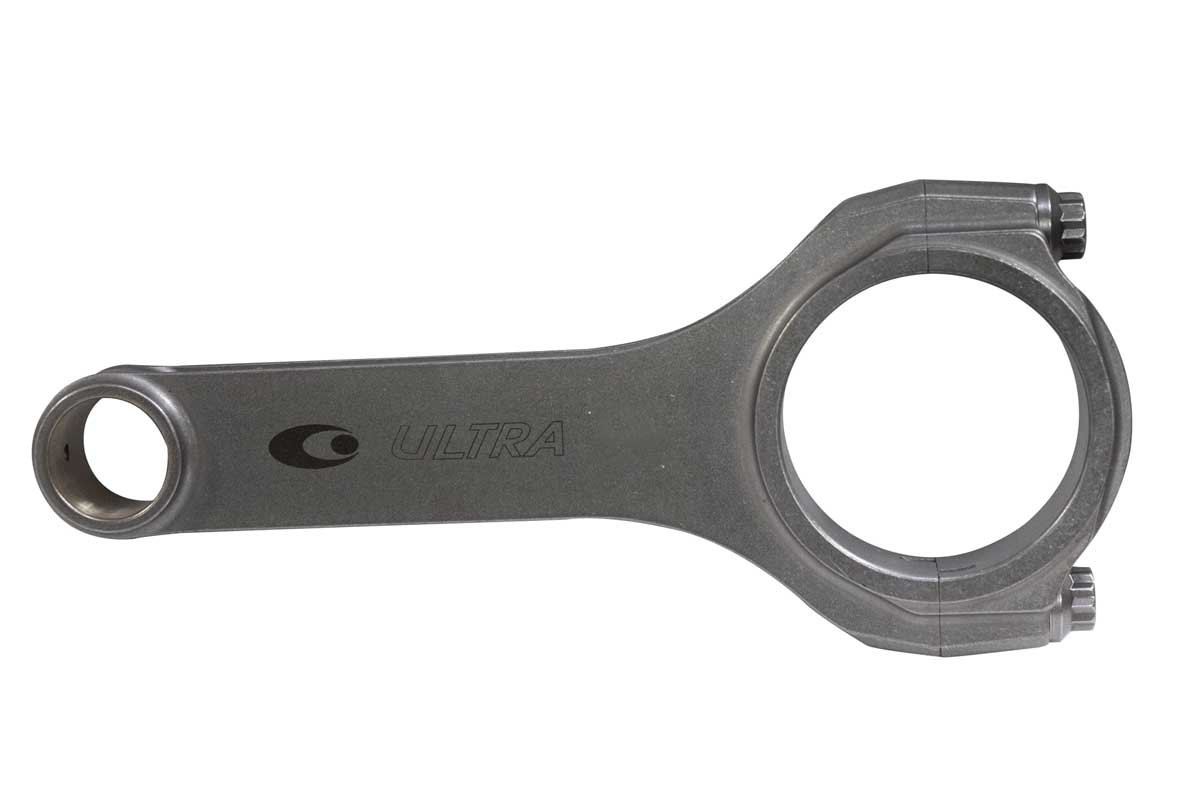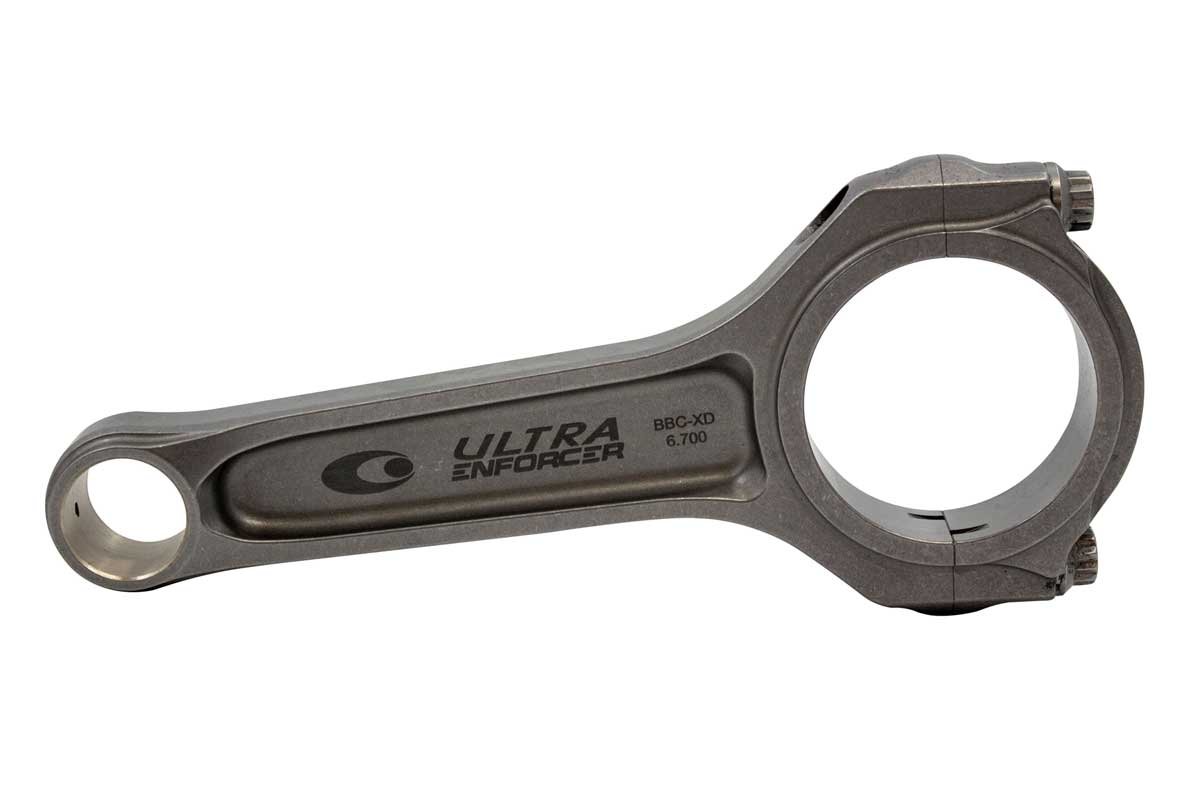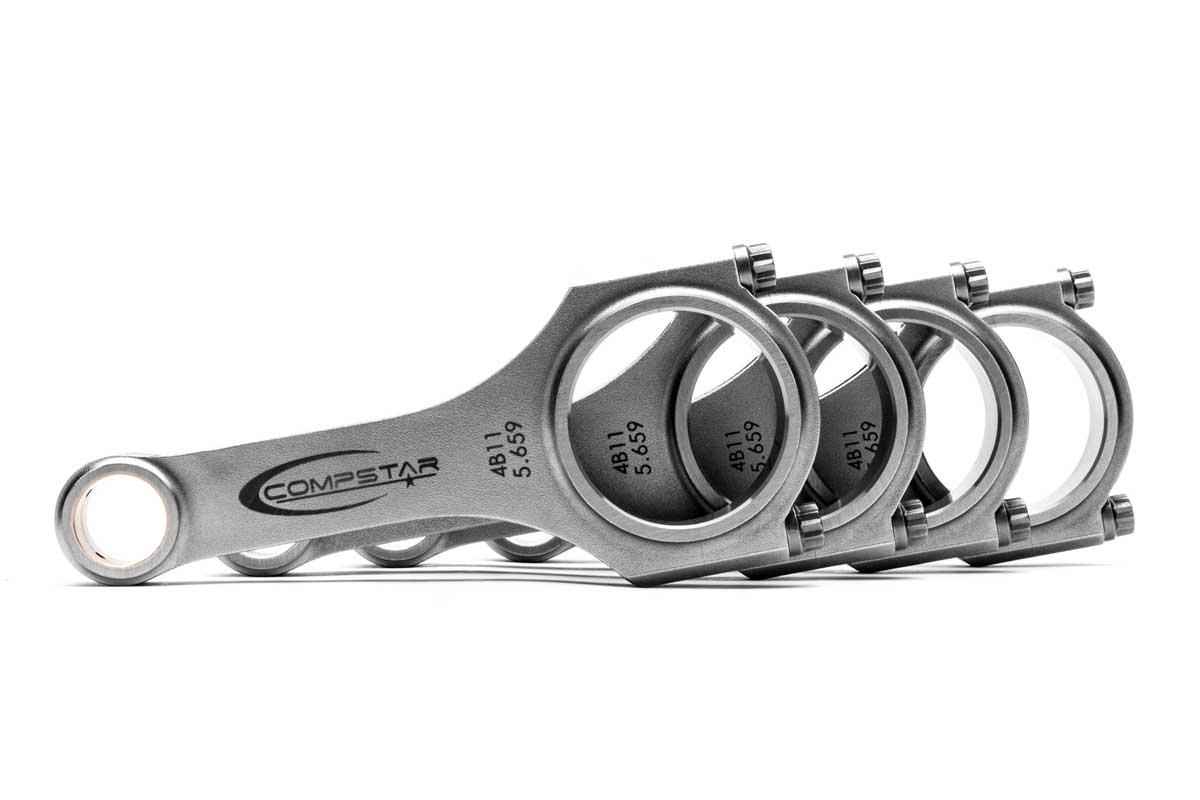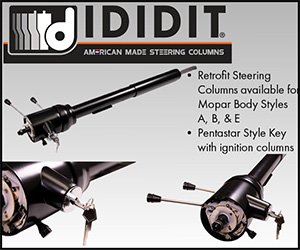
Recently, Mopar Connection Magazine shared an Engine Builders’ “Intellectual Horsepower” video featuring Callies Performance Products President Heath Norton, Sales Manager Brook Piper, and Billy Briggs of Billy Briggs Racing Engines speaking about connecting rods.
A connecting rod is a crucial component in an internal combustion engine. It connects the piston to the crankshaft, transferring its motion to the crankshaft and then converting its linear motion into rotational motion to drive the vehicle.
While Callies is renowned for its crankshaft expertise, the company also caters to a diverse range of engine builders with its comprehensive lineup of connecting rod designs. From street enthusiasts to all-out race engine builders, Callies offers the high-performance Ultra series and the Compstar rods; each precision-engineered to meet specific needs and deliver exceptional results.

Above: Ultra I-Beams are available in a standard-weight version for extreme-duty racing applications. A Custom Age bolt upgrade is available for all Callies I-Beam connecting rods for superior clamping.
Callies Ultra connecting rods stand out for their meticulous craftsmanship. Made from proprietary steel forged in Trenton, Michigan, and manufactured 100% in the Fostoria, Ohio, facility, these rods undergo a precision manufacturing process that ensures each customer receives a superior-quality finished product.
The Ultra I-Beams are a standard-weight version for extreme-duty racing applications. A bolt upgrade is available for all Callies I-Beams for additional clamping force. The Ultra H-Beam configuration, the newest addition to the expanding Callies connecting rod line, is designed to meet the demands of most racing applications, ensuring that the engine builder’s needs are met. The Ultra XD rods are intended for long-stroke engine applications, providing extra cam clearance.
The Compstar rods, Callies’ economy line of rods, are a testament to the company’s commitment to quality. Each rod is prepared offshore with Callies’ forging dies and then finished-sized at the Fostoria, Ohio, facility. Like all Callies products, the rods are meticulously planned and manufactured from start to finish, ensuring the highest quality and reliability.

Above: The Ultra H-Beam configuration is made of premium-grade TimkenSteel material. Each Ultra H-Beam connecting rod is designed to satisfy the requirements of the most demanding racing applications.
Ask any engine builder or connecting rod manufacturer, and you will hear, “Connecting rods tend to be taken for granted—until they break.” When a rod fractures, the only salvageable parts are often the intake manifold and the headers; everything else is junk.
Connecting rods must withstand the compression force of thousands of pounds of pressure, endure the tension loads created by the piston’s inertia at top dead center (TDC), and survive the bending compression loads attempting to push the piston through the major thrust side of the cylinder wall.
An example of stressing a rod beyond its limits occurred nearly forty years ago while I was in high school. A kid named Tony, a grade ahead of me, had a Mopar stroker engine he put together long before the numerous stroker kits available today. A stroker engine is a type of modified engine with an increased stroke, resulting in greater displacement and power.

Above: The Enforcer I-beam connecting rods, designed with fortified tower flanges, are ideal for boosted engines. The rods are produced from clean 4330V TimkenSteel. With increased mass and pressure Angle Arches, wrist pin stability is guaranteed. With robust tower flanges, the rod design resists bending and twisting.
Tony’s dad, Lawrence, the owner of the local machine shop, agreed to teach him how to make a stroker engine if Tony provided the parts. As a high school kid, Tony relied on the inexpensive parts sourced from the local wrecking yard.
Tony scored a 400 block from an early ‘70s truck. The block came with a forged steel crankshaft. Lawrence welded the rod journals and offset ground them to increase the stroke from 3.360 inches to 4.250 inches, an increase of 0.890 inches. Things got strange at this point.
Each crankshaft rod journal was machined to accommodate the connecting rods, 198 slant six rods. Why? Well, they were available for free. The rod widths were reduced from 1.218 inches to 1.018 inches, and the small ends of the rods were bushed and sized to the factory specs. The big ends of the rods were fitted with high-quality rod bolts and resized.

Above: Compstar high-performance connecting rods have what it takes to make your engine build trouble-free and your finished product dependable. Bolt upgrades and stroker clearance, normally additional cost options, are standard equipment with Compstar rods. ARP 2000 bolts are used exclusively for superior tensile strength and clamping force at the critical mating joint of the rod and cap. Strengthening gussets are added to the bolt spot-face area of the cap. These gussets increase strength and dimensional stability.
The information about the pistons is lost to time, but with Tony’s limited funds, something off the shelf was most likely found to have the correct bore size of 4.370 inches (0.030 inches overbore). Additionally, the wrist pin compression height on the piston must have been adequate to achieve a decent compression ratio when matched with a pair of 906 big-block heads. Possibly, Lawrence kicked in a few bucks for custom slugs.
The combination resulted in a 510 cubic inch engine. Because of the extensive machine work on the rods, each rod’s weight dropped from approximately 805 grams to somewhere in the 730 to 750-gram range. The rods were nearly as light as ones from a 273 or 318.
Lawrence stated, “The engine will stay together as long as it isn’t spun much above 5500 rpm.” The rod ratio (the rod length divided by the stroke length) was 1.65, lower than all of Mopar’s small—and big-block offerings in the muscle car era but still acceptable.

Above: Compstar H-beam rods have dimensional repeatability and the proper clearances for high-performance use right out of the box. Each rod is constructed of 4340 material. Attention to detail, high quality, and affordability are a trademark of Compstar rods.
Tony slipped the big block into the Duster during auto shop class, and after fine-tuning the engine, it ran well. However, Tony continued to push the limits of the engine. It was rumored that the tachometer needle often swung past 7,000 rpm nearly every Friday or Saturday night when the Duster was engaged in acceleration contests.
At 7,000 rpm, the piston speed, which is the speed the piston moves up and down in the cylinder, approached nearly 5,000 ft/min, well beyond the generally accepted maximum piston speed of 3800 to 4000 ft/min in a production engine, which essentially Tony’s engine was. A high piston speed stresses the rotating assembly, including the connecting rods.
Things went sideways one summer evening at Southeastern Dragway in Dallas, Georgia. Tony had loaded up the 8 ¾-inch rear end with 5.13:1 gears. After a few runs in the 6.40s in the 1/8th, he lined up the Duster for the first round of eliminations.

Above: Engines with shorter rods (left) mean the overall height of the block can be lower. That translates into an overall lighter weighing block. The engine typically pulls more vacuum at low RPM, resulting in better throttle response and low-end torque. Engines with longer rods (right) usually provide greater torque at higher RPMs with the same piston force. The rods have a reduced angle at a 90° crank pin position than shorter rods. Thus, the longer rods minimize sidewall loading and friction.
Tony watched the tree count down and launched on the last amber. The 1-to-2 and 2-to-3 shifts of the Torqueflite went perfectly, but as the Duster approached the finish line traps, a connecting rod or rod bolt cut loose. Hard on the brakes, the Duster slipped back and forth in the engine’s oil, but Tony kept it off the guard rails and on all fours.
Back in the pits, we noticed windows in the block. As stated previously, Tony kept the manifold and the headers, but all the rotating assembly, block, oil pan, and camshaft components were lost, and the heads were seriously damaged. After that summer, I lost touch with Tony and the Duster, but the crazy engine build made an impression.
The rod ratio, also known as the rod-to-stroke ratio, describes the relationship between the connecting rod’s length and the engine’s stroke length.
The effects of high rod ratios (Long Rods) are:
• Less rod angularity – reduced piston wear
• Lower piston velocity and acceleration – reduced tensile loading of the rods
• Less ignition timing is required – resists detonation
• Longer TDC dwell time – increased time to burn the air/fuel charge for greater efficiency
• A slight compression increase can be achieved before detonation is a concern
• Less intake runner volume is required
• High RPM breathing is improved
• Reduces scavenging at low RPM (weaker low RPM power)
The effects of low rod ratios (Short Rods) are:
• Increased rod angularity – increased ring, piston, and cylinder wear
• Increased piston velocity and acceleration increase the tensile loading of rods
• Increased scavenging at low RPM (increased low RPM power)
• Reduced TDC dwell time (reduced high RPM efficiency)
Production engines may have rod ratios ranging from 1.4 to over 2.0, with many falling in the 1.6 to 1.8 range. V8 engines typically range from 1.7 to 1.9, while V6s fall into a similar range of 1.7 to 1.8. Four-cylinder engines tend to have lower rod ratios, ranging from 1.5 to 1.7.

Above: Callies website describes plenty of rod enhancements that place them at the top of the list of connecting rod manufacturers. The added attention to each rod provides each engine builder with rods that will withstand extreme cylinder pressures and rod loads without failure.
The rod ratio is often a byproduct of the block’s design and deck height, as well as the pistons, rods, and crankshaft that can fit into the block. Engine builders and designers balance the rod ratio to achieve the desired power, efficiency, durability, and engine characteristics suitable for the intended application.
Callies Performance Products has connecting rods for late-model Hemis and Dodge Vipers for those looking to improve their engine’s bottom-end strength. Additionally, Callies has several Chevy rods that work with stroker Mopar engines.
Callies’ standard and lightweight I-beam connecting rods contain an extended footprint at the joint mating surfaces for superior housing stability. The rods include a Camber Face of twin tower flanges to improve stiffness, reduce stress risers, and lower weight.

Above: Additional information from Callies website continues explaining the benefits of Callies rods over the competition.
Only AMS 642 bronze silica alloy is used in the wrist pin bore to eliminate deformation and extrusion. The material is 26% harder than the commonly used Ampco 18 material. Additionally, Pressure Angle Arches disperse the wrist pin-induced strain.
Callies’ H-beam rods have ARP Nickel Alloy Custom Age 625 cap screws. The rod bolts are available for highly demanding applications. At the wrist pin area, Pin Hoop Stiffening Bands significantly improve the wrist pin bore cylindricity during periods of high RPM or heavy deceleration. The bands also aid in maintaining a uniform oil film across the entire length of the wrist pin bore.
If Tony was designing a late-model Hemi stroker today, it is guaranteed that a Callies bottom end would stay together, regardless of the rod ratio. For more information about Callies crankshafts, connecting rods, and even camshafts, contact its representatives to get the best and most cost-effective bottom-end components.
















